#Palinuridae
Explore tagged Tumblr posts
Text

California Spiny Lobster (Panulirus interruptus), family Palinuridae, off the coast of California, USA
photograph by Brett Seymour | NPS
3K notes
·
View notes
Text

A California spiny lobster (Panulirus interruptus) in Channel Islands National Park, California, USA
by Water Planet
#california spiny lobster#spiny lobsters#lobsters#crustaceans#panulirus interruptus#panulirus#Palinuridae#decapoda#malacostraca#arthropoda#wildlife: california#wildlife: usa#wildlife: north america
54 notes
·
View notes
Text






Crustacea: Panulirus versicolor
During my free time on Woppa, I did some snorkelling. It was fucking scary, but fun. Without an underwater camera, I sadly couldn't take photos of the things I saw. BUT I did collect a handful of items off of the reef/sand (anything I took, I returned to the reef closest to shore).
The most impressive thing was this lobster tail. It seems all the good parts had been eaten, leaving behind this big ass tail. I consulted an ex-diver about the ID, apparently these things can go for thousands in high-end restaurants (the guy got 40 bucks for capturing a perfect one... middlemen make all the money). I know lobsters are the cockroaches of the ocean, but I think they're really cool.
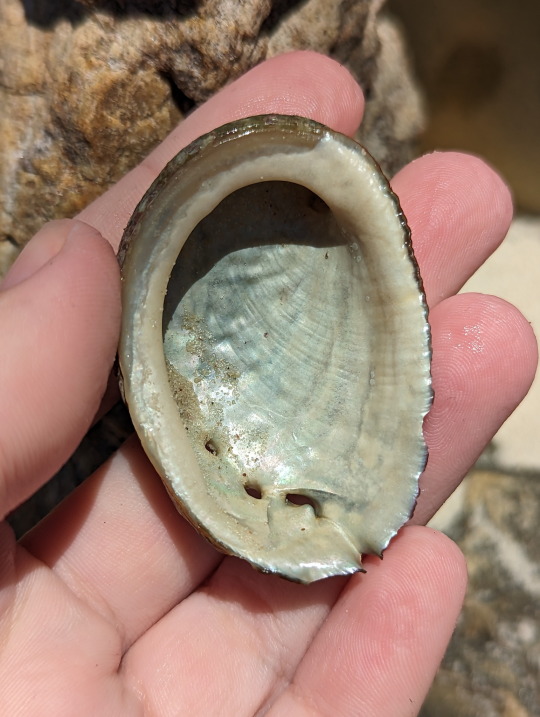
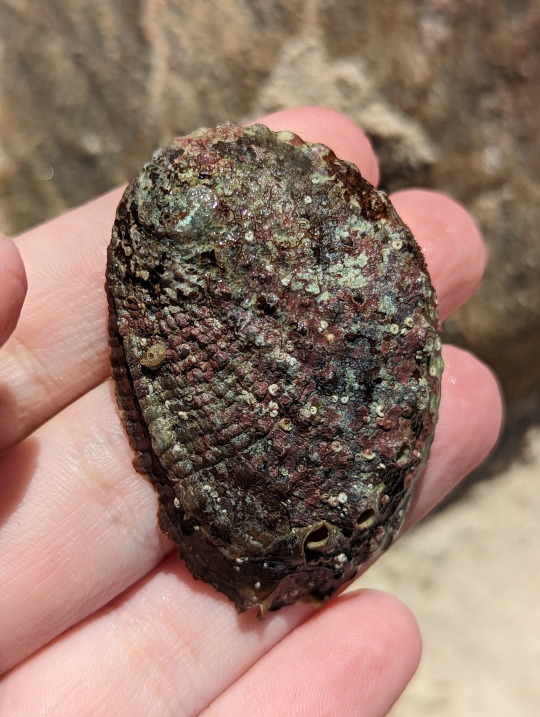
Gastropoda: Haliotis sp.
The second thing I picked up was this abalone shell (also used as food lol). The interior of these shells is really shiny when polished. I've never come across one of these snails before, so I had to pick it up.
Here's a short list of the other things I saw but couldn't photograph: (what I remember clearly, lots of fish I couldn't ID)
Blackeye Thicklip
Goldstripe Butterflyfish
Giant Clams
The large variety of coral (mostly red)
School of pipefish (I think) found near shore
I wouldn't mind doing snorkelling in the future, though I'm certainly going to teach myself how to do it better lol. I will keep an eye for sharks too. This was a popular tourist diving spot, but even still, you've gotta be careful.
13/09/23 - Woppa, reefs near Shelving Beach
#invertebrates#invertblr#arthropod#arthropoda#Haliotis#Abalones#Gastropoda#Gastropods#Vetigastropoda#Mollusca#Molluscs#Panulirus versicolor#Painted Spiny Lobster#Palinuridae#Spiny Lobsters#lobsters#Decapoda#Decapods#Crustacea#Crustaceans#snorkelling#marine biology#great keppel island#great barrier reef#reef#diving#snails
20 notes
·
View notes
Text
#2511 - Jasus edwardsii - Southern Rock Lobster


AKA red rock lobster, or spiny rock lobster, Jasus novaehollandiae, Palinurus edwardsii, crayfish in Australia and New Zealand and kōura in te reo Māori.
Found throughout coastal waters of southern Australia and New Zealand including the Chatham Islands. They resemble lobsters, but lack the large pincers.
The leaf-like phyllosoma larvae spend between 9 months to 2 years as plankton before metamorphosing to the post larval puerulus, which then swims towards the coast to settle.
Highly prized for food, and potentially an aquaculture species.
Pariwhero, Wellington, New Zealand
2 notes
·
View notes
Text

Range: Pacific Ocean around Japan, Taiwan, China, & Korea
27 notes
·
View notes
Text
We need more big crabs in gaming. Maybe even giant crayfish too.
#art talks about stuff#for any americans reading this post in this instance the term crayfish refers to spiny lobsters (Palinuridae)#as that's what i know as crayfish
0 notes
Text

L Hermione passing the Phare de Tévennec, Brittany France

Bethany Hamilton. Maldives.

California Spiny Lobster (Panulirus interruptus), family Palinuridae, off the coast of California, USA
3 notes
·
View notes
Text

#Spinylobsters, also known as langustas, langouste, or rock lobsters, are a family (Palinuridae) of about 60 species of achelate crustaceans, in the Decapoda Reptantia. Spiny
2 notes
·
View notes
Text
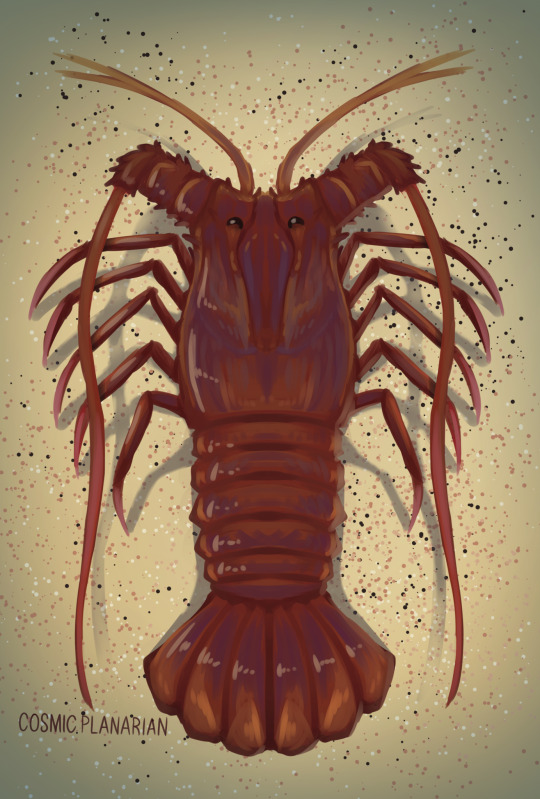
100 Days of Sea Creatures Day 97 - Spiny Lobster (Palinuridae)
#artists on tumblr#artists on instagram#drawing challenge#sea creature art#drawing daily#sea creatures#deep sea creatures#spiny lobster#lobster
4 notes
·
View notes
Photo

California spiny lobster (Panulirus interruptus)
Photo by David R. Andrew
#california spiny lobster#spiny lobster#panulirus interruptus#panulirus#palinuridae#achelata#pleocyemata#decapoda#eucarida#eumalacostraca#malacostraca#multicrustacea#crustacea#pancrustacea#arthropoda#panarthropoda#ecdysozoa
44 notes
·
View notes
Note
Do you have any lobsters? My friend loves lobsters
DO I HAVE ANY LOBSTERS?!?!
I HAVE SO MANY LOBSTERS...
Let me show you... Here, let's have a look at lobsters from 3 different taxonomic groups...
SPINY LOBSTERS (family Palinuridae)
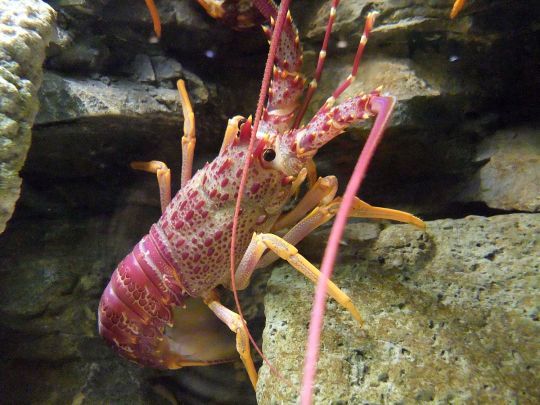
Southern Rock (Spiny) Lobster (Jasus edwardsii), family Palinuridae, found in coastal areas around Australia and New Zealand
photograph by Stemonitis

Ornate Rock Lobster (Panulirus ornatus), family Palinuridae, Fly Point, Port Stephens, NSW, Australia
photograph by Richard Ling

California Spiny Lobster (Panulirus interruptus), family Palinuridae, off the coast of California, USA
photograph by Brett Seymour | NPS
REEF LOBSTERS (family Enoplometopidae)
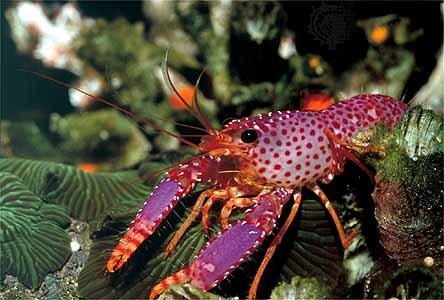
Violet-spotted Reef Lobster (Enoplometopus debelius), family Enoplometopidae, found around the Pacific Ocean
photograph by reef-guardian.com

Atlantic Reef Lobster (Enoplometopus antillensis), family Enoplometopidae, found in warmer parts of the Atlantic Ocean
photograph by Fernando Herranz Martín

Hawaiian Red Reef Lobster (Enoplometopus occidentalis), family Enoplometopidae, Hawaii
This species is normally red, but this individual has just molted.
photograph by Drew R. Smith
TRUE or TYPICAL LOBSTERS (family Nephropidae)

European Lobster (Homarus gammarus), family Nephropidae, found in the eastern Atlantic
photograph by H. Zell

American Lobster (Homarus americanus), family Nephropidae, found off the Atlantic coast of the NE U.S. and eastern Canada
photograph via: University of Maine
#lobster#decapod#crustacean#spiny lobster#reef lobster#ocean#homarus#nephropidae#Enoplometopus#Enoplometopus occidentalis)#family Enoplometopidae#Panulirus#palinuridae#jasus#aniamls#nature
525 notes
·
View notes
Photo
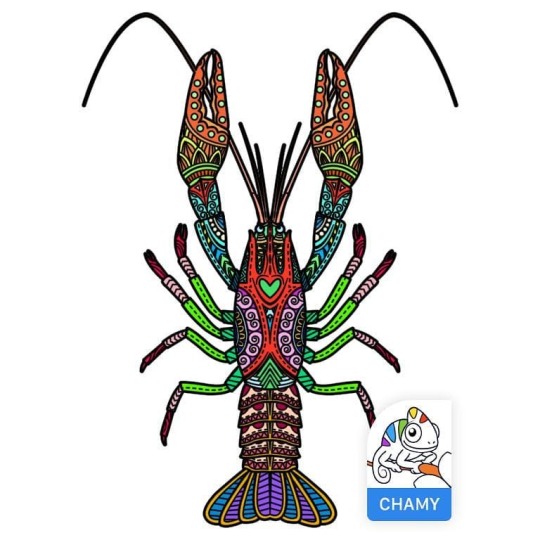
#chamyapp #krebs #hummer #languste #palinuridae #gliederfüßer #meeresbewohner #meeresfrüchte #meer #ozean #crayfish #crustacean #lobster https://www.instagram.com/p/B7ievAnifMZ/?igshid=1ubk1aj0o33qv
#chamyapp#krebs#hummer#languste#palinuridae#gliederfüßer#meeresbewohner#meeresfrüchte#meer#ozean#crayfish#crustacean#lobster
0 notes
Text
Spiny Lobster: Spiny and Clawless but Colorful Nonetheless
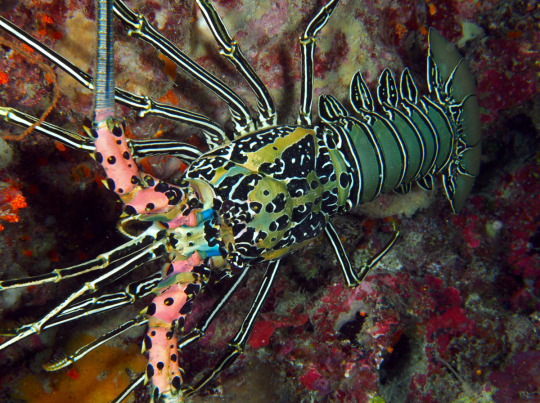
Photo from: Florent’s Guide to the Tropical Reefs
Yes, you read it right! Apparently there exists a lobster (Family Palinuridae) without claws. It may not be the one you’ve exactly imagined when you see those crustaceans whose claws are clamped in an aquarium outside a seafood restaurant but we’re pretty sure these lobsters saved the chef from some pinches. To some punctures? That we don’t know. It is named spiny lobster afterall!
I. Classification
Kingdom: Animalia
Phylum: Arthropoda
Subphylum: Crustacea
Class: Malacostraca
Subclass: Eumalacostraca
Superorder: Eucarida
Order: Decapoda
Suborder: Pleocyemata
Infraorder: Achelata
Family: Panuliridae
Genus: Panulirus
Species: versicolor (Fofonoff et. al. 2018)
II. Distribution: Hi! So my address is just right here..

Photo from: Lavery et. al. 2014
Known as the Painted Spiny Lobster, they are native to the Indo-Pacific waters and are distributed in the Red Sea, South Africa, Southern Japan, Northern Australia, Micronesia, and Polynesia. However, the first non-native occurrence is reported in the Brunswick River, Georgia (Fofonoff et. al. 2018).
III. Anatomy: Pinching for that Body Plan
Extenal Anatomy

The external anatomy of a true lobster (Family Nephropidae) is composed of two parts: The Cephalothorax and the Abdomen as depicted above. The same is true for spiny lobsters but the Paniluridae traversed a different way in the path called evolution.
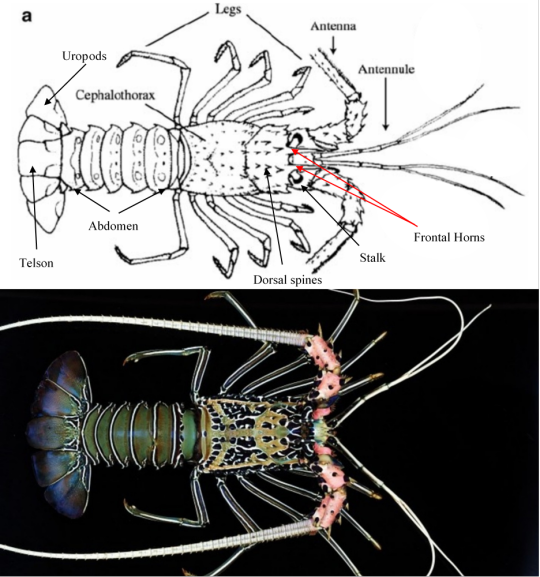
Photo from: Charles Derby 2011 (up) and Nemesis Database Species Summary (down)
So what do true lobsters have that spiny lobsters don’t? Or better yet what makes spiny lobsters unique from other lobsters?
Spiny lobsters lack the prominent claws and rostrum associated with true lobsters and instead have two frontal horns and prominent dorsal spines (Fofonoff et. al. 2018). Its body is tubular in shape with all of its legs not possessing true pincers and the first pair is not enlarged (Tavares). The antennae are cylindrical, enlarged, and longer than its body. The total body length reaches up to 400mm, but the average maximum size is around 300mm. The male spiny lobster tends to be larger than females (Fofonoff et. al. 2018).
Panulirus versicolor’s carapace has a whitish background, with large areas of bluish-black. The abdomen, on the other hand, is predominantly green in color and the telson is a mix of bluish-black and green. The legs are lined with black and blue stripes. The antenna is pinkish-red in the thicker and lower segments and becomes white ringed with black rings in the upper segment (Sutton 2017).

Photo by: Sutton 2017
The following are brief functions of the spiny lobster’s general external anatomy:
Shell: This part is the lobster’s exoskeleton, made from chitin, which serves as a protection for the internal anatomy. However, for the lobster to grow, it sheds its shell in the process called molting.
Antennae and Antennules: The antennae and antennules of the lobster are used as chemoreceptors, which detect odors and chemical signals to help them in locating food, mate, and avoid danger. In spiny lobsters, the antenna is longer than the antennules.
Stalks: For their vision, lobsters have long and stalked compound eyes. Although stalked, their vision is not that excellent, and can only see images in dim light.
Legs: Since they are under Decapoda, they have 10 legs that are used by the animal to navigate its way on the seafloor.
Tail fan: This is the last segment of the lobster. It has a telson as the center tail fin and pairs of uropods at both sides and is used for backward propulsion.
Internal Anatomy
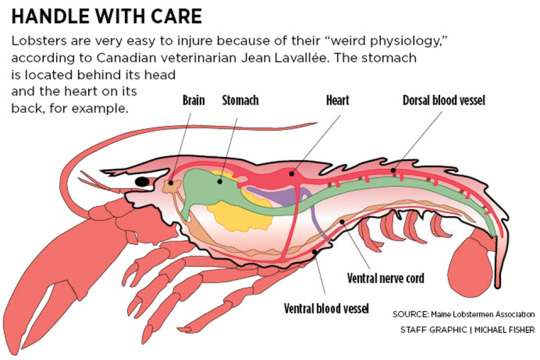
These creatures as a member of the Decapod group have internal organs that are the same as the other species. Its circulatory system is open, unlike humans. They have a single-chambered heart that is composed of muscles and ostia, or openings. Usually, the heart of an adult lobster beats for 50-136 beats per minute.
IV. Reproduction and Life Cycle
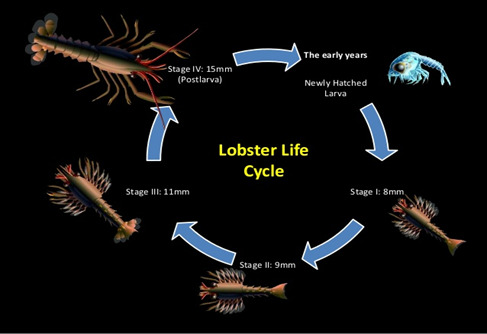
Photo from: Shiran Weerathunga, 2014
A day in a lobster’s life, they reach sexual maturity at the age of 5 to 6 years. The male’s task is to mate with as many female lobsters there is. Usually, they mate to a depth of 50 to 100 feet of water. As they mate, the male will deposit its spermatophore or known as the plaster in the female’s belly. After a while, the female will move to waters less than 30 feet deep, and when she is ready to spawn, she will use the pincers on her fifth walking leg to cut the plaster and fertilize her 80,000 to 800,000 eggs.
These eggs will be deposited under her tail, where she will perform parental duties until they hatch 9 to 10 weeks later. Usually, the larvae are transparent, large, pigmented eyes with long legs, and have little resemblance to adult lobsters. After 7 to 9 months they drift with the currents and eat plankton, after which they go to shallow water and settle at the bottom. Their lifespan is estimated to be 15 years (Cardone 2008; NOAA Fisheries 2020).
Check out this video of spiny lobsters mating!
youtube
and these cute baby lobsters!
youtube
V. Ecology
Habitat
They are found living singly or in groups in shallow water ranging from the low-tide marks up to 15 m depth and often reside in rocky areas, coral reefs, and overhangs that provide them protection (Fofonoff et. al. 2018; Mortiz 2010).

Photo by: Aquapix
Feeding Habit and Predators
Spiny lobsters are nocturnal and carnivore feeders. They even exhibit cannibalism at some point in their lives.They remain hidden in their reef or rock shelters called dens during the day and hunt during night for a variety of mollusks, shrimp, crabs, worms, and sea urchins (Sutton 2017). They use their strong legs to pry open their prey. Meanwhile, spiny lobsters are a delicacy not only to humans but octopus, groupers, and trigger fishes as well.
Be fascintaed with this video on how spiny lobsters protect themselves from a trigger fish.
youtube
VI. Relationship with Humans
Ornamental organisms
The juvenile painted spiny lobster displays a vibrant and attractive coloration of blue and purple body with white antennae which has attracted the market of tropical marine aquarium trade (Fofonoff et. al. 2018).

Photo by: Rokus Groeneveld & Sanne Rejis
For consumption
Spiny lobsters in general are eaten and are regarded as a delicacy. The meat located at the lobster’s abdomen proved to be very tasty and chewy.
youtube
While the lobster is a rich source of copper and selenium, it contains very high cholesterol, thus, it should be eaten in a regulated manner. Additionally, lobster contains zinc, phosphorus, vitamin B12, magnesium, vitamin E, and a small amount of omega-3 fatty acids (Ware 2018).
For livelihood
As of 2011, Panulirus spp. farming has not been reported in the last years to FAO but the species are cultured in Vietnam, Indonesia, Malaysia, and Philippines (Clive and Shanks 2009). Philippine waters are a natural resource of seeds for lobster farming and so there is a regional trade in peuruli and juveniles to establish spiny lobster farming.

Photo from: Mercator Media Ltd 2020
However, an article published in 2018 says that BFAR will bring the lucrative lobster culture to poor communities in Eastern Visayas by providing the cages and feeds to the beneficiaries (Meniano 2018). According to BFAR, the lobster culture is very ideal not only because of the strong demand from China and Taiwan but also because it is very expensive (4,000 per kilogram) (Meniano 2018).
VII. Did you know?
1. Lobsters pee out of their heads. While their anus is located posteriorly, their bladder is found under its brain and the opening is located at the base of their antennae, or just under their eyes!

2. The female lobster takes "her clothes off" to mate. Female lobsters “take off” their shells during molting and it is in this process that they decide to mate as well.

3. Lobsters have two stomachs. To make things even more weird, the first stomach located on its head has teeth! It functions to crush food and the second aids in digestion and is located at the abdomen.
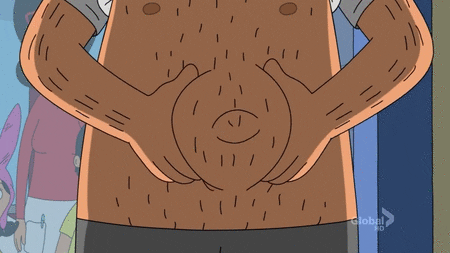
4. Lobsters can detach one of their limbs in an emergency. Don’t worry, they are able to regrow it during the molting process.(Yes, the organism in the video is a crayfish but the mechanism is the same with their lobster cousins!)
youtube
5. In the 17th century, lobster was anything but a delicacy. In fact, a field guide by Motoh from Southeast Asian Fisheries Development Center in 1980 said that the spiny lobster sells for about ₱55/kg in Manila and ₱40/kg in local areas! Now, as stated above, it costs ₱4,000/kg!
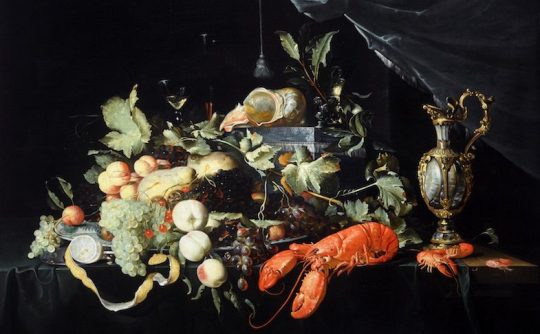
Photo from: Creative Tourist (Courtesy of Barnsley Museum)
6. The blood is known as the hemolymph and is color blue due to the presence of Copper.

Photo from: @WhatTheFFacts on twitter
VIII. References
American Lobster. (2020). Overview of Homarus americanus: The American Lobster. Retrieved November 9, 2020, from, http://www.parl.ns.ca/lobster/overview.htm
Cardone, B. (2008). The Lifecycle of Spiny Lobsters - California Diving News. Retrieved November 10, 2020, from https://cadivingnews.com/the-lifecycle-of-spiny-lobsters/
Clive, J., Shanks, S. (2009). Requirements for the aquaculture of Panulirus ornatus in Australia. Australian Centre for International Agricultural Research, 98-109
Fofonoff PW, Ruiz GM, Steves B, Simkanin C, & Carlton JT. (2018). National Exotic Marine and Estuarine Species Information System. Retrieved November 9, 2020, from, http://invasions.si.edu/nemesis/
Lavery S.D., Farhadi A., Farhamand H., Chan T.Y., Azhdehakoshpour A., Thakur V., Jeffs, A. (2014). Evolutionary Divergence of Geographic Subspecies within the Scalloped Spiny Lobster
Panulirus homarus (Linnaeus 1758). Retrieved November 9, 2020, from,DOI: 10.1371/journal.pone.0097247
Meniano, S. (2018). BFAR eyes lobster farms in 3 Eastern Visayas provinces. Retrieved from Philippine News Agency: https://www.pna.gov.ph/articles/1042610#:~:text=Lobster%20culture%20is%20very%20ideal,high%20preference%20for%20live%20lobsters.&text=A%20fishermen%20can%20raise%20up%20to%20100%20lobster%20juveniles%20in%20a%20cage.
Mortiz. (2010). Family Palinuridae - spiny lobsters. Retrieved from SealifeBase: https://www.sealifebase.ca/Summary/FamilySummary.php?ID=13
Motoh, H. (1980). FIELD GUIDE FOR THE EDIBLE CRUSTACEA OF THE PHILIPPINES. Iloilo, Philippines: SOUTHEAST ASIAN FISHERIES DEVELOPMENT CENTER (SEAFDEC) .
NOAA fisheries. (2020). Caribbean Spiny Lobster. Retrieved November 10, 2020, from https://www.fisheries.noaa.gov/species/caribbean-spiny-lobster#:~:text=Spiny%20lobsters%20may%20live%2015,3.6%20inches%20in%20the%20Caribbean.
Sutton, A. (2017). Painted Spiny Lobster – Facts and Photographs. Retrieved from Seaunseaan: https://seaunseen.com/painted-spiny-lobster-facts-and-photographs-clone/
Tavares, M. (2002). The living marine resources of the western central Atlantic. FAO Species Identification Guide for Fishery Purposes Area 51 and American Society of Ichthyologists and Herpetologists, 294-325.
Ware, M. (2018). Everything you need to know about lobster. Retrieved from Medical News Today: https://www.medicalnewstoday.com/articles/303332
#lobster#spinylobster#paintedspinylobster#Panulirus#Panulirisversicolor#Panuliridae#invertebrates aquaticinvertebrates
19 notes
·
View notes
Photo



Photos: Benjamin Seetor, The Straits Times, Gills N Claws
Fish farm might close due to oil spill Fish farms in Pulau Ubin in costly ordeal after oil spill from vessels collision reaches them By Kimberly Lim, 7th January 2017;
It has been an anxious three days for Mr Steven Suresh, who has been shuttling between his office in mainland Singapore and his fish farm located in north Pulau Ubin.
Gills N Claws, an aquaculture company, has a total of $500,000 worth of seafood at stake because of the oil spill in Johor, said the 46-year-old chief executive officer.
He is waiting for the Agri-Food and Veterinary Authority of Singapore (AVA) to release the results of food safety tests conducted on the fish samples.
The Tuesday night collision between two container vessels saw 300 tonnes of oil spillage.
By the following night, patches of oil were seen along the beaches of Singapore's north-eastern coast.
Mr Steven said: "This whole experience has been horrifying and shocking. I really do not know what to do.
"We have been waiting for AVA's reply to find out if we can still salvage any of our fish."
The future for the company remains uncertain for now, he added.
"We have no insurance for the farm because it was not made available to us. We were affected by the red tide during the previous two years and we were just recovering from that when the oil spill happened," he said.
Mr Steven expects the results to be out by tomorrow. But sales to restaurants, fishmongers and wholesalers have been brought to a standstill.
He said: "We have 40 tonnes of fish stocked up for the Chinese New Year, with each tonne costing up to $7,000. From my experience, my fish are definitely gone already. We cannot pull out the net or feed the fish.
"We also have four tonnes of lobsters, costing $55,000 per tonne. As far as I know, the lobsters are gone too - nobody will want to buy lobsters with oil coated on them."
Mr Steven added: "The clean-up for the farm will take at least four months to complete and our business will have to stop because of it."
He said the farm has to undergo structural changes on top of purchasing new nets and high-density floating polyethylene cubes.
There is a high chance the company will close down because of the time required to clean up, he said.
Mr Tan Choon Teck, owner of FC57E Fish Farm, also sent fish samples to AVA for testing.
The 54-year-old said in Mandarin: "AVA came to collect the fish sample on Wednesday but has not notified us on when the results will be released.
"I have not estimated the losses made but some of my small fishes have died."
He added: "I have been feeling very anxious because I am afraid that more fish will die. I have also been very busy with cleaning the oil."
Some fish farms have managed to escape the ordeal.
Among them is The Fish Farmer, located in the south of Pulau Ubin.
Mr Malcolm Ong, 53, the chief executive officer, said: "We were unaffected by the oil spill but it came close to the farm and skirted right past us.
'Small Community'
"I feel very lucky and fortunate, but also a bit pained for our fellow farmers because we are a small community. It is a big blow for them and we hope that they can recover from this."
AVA has been visiting coastal fish farms in the East Johor Strait to assess the situation and assist in the clean-up, such as issuing oil absorbent pads and canvas to 25 farmers closest to the oil spill.
Some farms have reported loss of 250kg of fish.
AVA said: "To ensure food safety, AVA has collected fish samples for food safety tests and will continue to do so. We have also issued suspension of sales to 12 farms as (of yesterday).
"The suspension will be in place until food safety evaluations are complete. Fish available in the market is safe for consumption."
Dr Leong Hon Keong, group director of AVA's technology and industry development group, said: "As compared to the day before, we have observed more farms with tainted nets and structures in the East Johor Strait due to the tidal movement.
"AVA will continue to monitor the situation and assist the fish farmers, including assisting in cleanup efforts."
The Maritime and Port Authority of Singapore (MPA) said: "Clean-up operations are still on going at Changi Point Ferry Terminal, fish farms at Nenas Channel, and at Noordin beach, northern coastline of Pulau Ubin. Oil spill response vessels as well as containment booms and spill recovery equipment, such as harbour busters, skimmers and absorbent booms and pads, have also been deployed."
Source: The New Paper
#oil spill#pollution#Straits of Johor#threats#human activities#Pulau Ubin#marine#fish farm#aquaculture#seafood#fishes#teleosts#mass death#fishkill#The New Paper#hybrid groupers#groupers#Epinephelinae#Serranidae#Perciformes#spotted scat#Scatophagus argus#Scatophagidae#spiny lobsters#Palinuridae#crustaceans
0 notes
Text
List of Families within Decapoda I’ve covered (each link leads to the tags for each family):
Inachidae
Ocypodidae
Palinuridae
Potamidae
6 notes
·
View notes
Note
Spiny lobsters, also known as langustas or langouste, are a family (Palinuridae) of about 60 species of achelate crustaceans, in the Decapoda Reptantia. Spiny lobsters are also, especially in Australia, New Zealand, Ireland, South Africa, and The Bahamas, called crayfish, sea crayfish, or crawfish ("kreef" in South Africa), terms which elsewhere are reserved for freshwater crayfish.
Good for them
0 notes